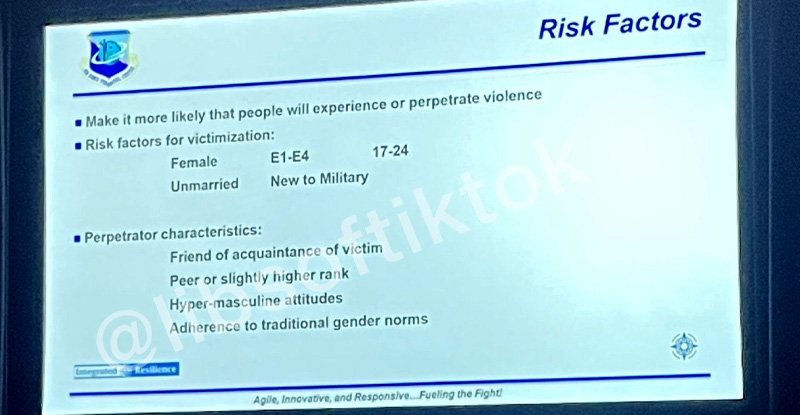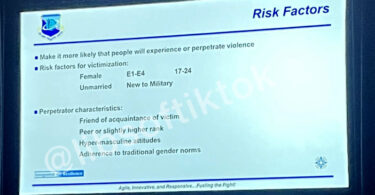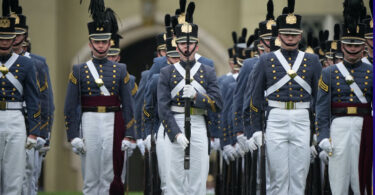Off we go again into the wild realm of woke insanity. A training slide for the Air Force and Space Force reportedly claimed that “adherence to traditional gender norms” is a characteristic of potential sexual assault perpetrators.
Libs of TikTok tweeted on X (formerly Twitter) on Oct. 6: “SCOOP: This is from the Air Force and Space Force training for Sexual Assault Prevention and Response.
They claim that one of the characteristics of a perpetrator of sexual assault, is ‘adherence to traditional gender norms.’”
SCOOP: This is from the Air Force and Space Force training for Sexual Assault Prevention and Response.
They claim that one of the characteristics of a perpetrator of sexual assault, is “adherence to traditional gender norms.” pic.twitter.com/tGjrakFCTd
— Libs of TikTok (@libsoftiktok) October 6, 2023
The other listed “perpetrator characteristics” were “friend of acquaintance of victim,” “peer or slightly higher rank,” and “hyper-masculine attitudes.”
While “hyper-masculine attitudes” could refer to some sexual assaulters’ warped theory that using and abusing women demonstrates their strength and male superiority, in the context of the “gender norms” nonsense, the Air Force and Space Force might simply be worried about men who like guns and dislike cross-dressing.
You know, the men we want in the military. One wonders.
. . . Unfortunately, radical LGBTQ ideology has permeated and poisoned the whole U.S. military thanks to woke leadership.
For instance, I covered a story in April where a medical practitioner was caught on video during a Navy-sponsored presentation in Bahrain saying that it’s U.S. military policy to ask children sexually explicit questions, including about “gender” orientation, without parental knowledge or permission. . . . (read more on PJ Media)
NOTE: This training is also being taught at the US Air Force Academy
We’re highlighting the below comment by ret USAF LTC Richard Coe:
This is an “interesting” slide from the Air Force Personnel Center. On the surface it seems to be focused on sexual assault and what characteristics to look for in a perpetrator of sexual assault.
However, the last two bullets seem more focused on demeaning societal norms and in particular those members of the military thought to be normal.
Who makes these slides up and who reviews them for factual accuracy? It would be “interesting” to review the bio of each of those individuals so that there is transparency as to their “expertise”.
One wonders if they have ever been in harms way when they needed the help of a cisgender hypermasculine male?
Since the slide indicates the people who adhere to gender norms are more likely to perpetrate sexual assault, I assume that is based on data from the military population as a whole.
This is a clear statement that the members of the heterosexual community are the ones most likely to be abusers. Is that true or is the author displaying a personal bias?
Let’s ask a different question – what percentage of the LGBTQIA population are perpetrators of sexual assault? Is that number greater or less than the percentage of abusers who adhere to gender norms?
Perhaps the author of this slide has not done their homework, is biased against societal norms or is just ignorant of the facts:
The CDC’s National Intimate Partner and Sexual Violence Survey found for LGB people:
- 44% of lesbians and 61% of bisexual women experience rape, physical violence, or stalking by an intimate partner, compared to 35% of straight women
- 26% of gay men and 37% of bisexual men experience rape, physical violence, or stalking by an intimate partner, compared to 29% of straight men
- 46% of bisexual women have been raped, compared to 17% of straight women and 13% of lesbians
- 22% of bisexual women have been raped by an intimate partner, compared to 9% of straight women
- 40% of gay men and 47% of bisexual men have experienced sexual violence other than rape, compared to 21% of straight men
- Within the LGBTQ community, transgender people and bisexual women face the most alarming rates of sexual violence. Among both of these populations, sexual violence begins early, often during childhood.
- The 2015 U.S. Transgender Survey found that 47% of transgender people are sexually assaulted at some point in their lifetime.
Those surveys don’t indicate what percentage of straight men and women have been subjected to rape, abuse or sexual violence from a member of the LGBTQIA community.
It would be “interesting” to have that data. The above statistics conflict with the “facts” on the AFPC slide. Perhaps the adherents to gender norms are more likely nice people?
The use of the term Hypermasculine always makes me shake my head. This word has become the junk pile of disliked traits for the anti-male community.
Hypermasculine people are the ones who try to attain the highest levels of physical strength, are aggressive and have no fear of danger – sounds like the perfect SEAL, Grunt, SOF Operator, Pilot, Pararescue, etc. Sign them up!!!
I always assumed the people who use the term hypermasculine are just railing against the fact that they can’t compete with those members of the human race that work hard to be effective as a warrior, or football player, or hockey player, etc., but you get the point.
How many Medal of Honor recipients and other awards for heroism recipients would be classified as hypermasculine?
How many firemen that run into a burning house to save families would be classified as hypermasculine?
How many policeman who encounter dangerous criminals would be classified as hypermasculine?
And don’t even start analyzing professional sports players.
Apparently, the opponents of hypermasculinity would like to see the military populated by the opposite: Hypomasculinity is a psychological term for the absence of male stereotypical traits – or just weak, nonaggressive, incapable of confronting the enemy and winning.
And finally, even DoD encourages the military to embrace traits of hypermasculinity:
DOD INSTRUCTION 1308.03 – The Military Services will design, implement, supervise, and tailor PF/BC programs to suit the particular needs and mission of their respective Military Service, consistent with established scientific principles of physical training. Meet occupationally-specific, operationally-relevant physical requirements for physically demanding career fields. This includes identifying specific physical capabilities required by the physically demanding occupational specialties (i.e., the occupation’s mission critical operational physical tasks).
Is it any wonder that the military is finding it difficult to recruit people.
The Center has the responsibility for managing personnel programs and carrying out policies affecting Air Force active-duty and civilian members, yet this presentation alienates the very people it needs to entice to join.








This is an “interesting” slide from the Air Force Personnel Center. On the surface it seems to be focused on sexual assault and what characteristics to look for in a perpetrator of sexual assault. However, the last two bullets seem more focused on demeaning societal norms and in particular those members of the military thought to be normal. Who makes these slides up and who reviews them for factual accuracy? It would be “interesting” to review the bio of each of those individuals so that there is transparency as to their “expertise”. One wonders if they have ever been in harms way when they needed the help of a cisgender hypermasculine male?
Since the slide indicates the people who adhere to gender norms are more likely to perpetrate sexual assault, I assume that is based on data from the military population as a whole. This is a clear statement that the members of the heterosexual community are the ones most likely to be abusers. Is that true or is the author displaying a personal bias? Let’s ask a different question – what percentage of the LGBTQIA population are perpetrators of sexual assault? Is that number greater or less than the percentage of abusers who adhere to gender norms? Perhaps the author of this slide has not done their homework, is biased against societal norms or is just ignorant of the facts:
The CDC’s National Intimate Partner and Sexual Violence Survey found for LGB people:
• 44 percent of lesbians and 61 percent of bisexual women experience rape, physical violence, or stalking by an intimate partner, compared to 35 percent of straight women
• 26 percent of gay men and 37 percent of bisexual men experience rape, physical violence, or stalking by an intimate partner, compared to 29 percent of straight men
• 46 percent of bisexual women have been raped, compared to 17 percent of straight women and 13 percent of lesbians
• 22 percent of bisexual women have been raped by an intimate partner, compared to 9 percent of straight women
• 40 percent of gay men and 47 percent of bisexual men have experienced sexual violence other than rape, compared to 21 percent of straight men
• Within the LGBTQ community, transgender people and bisexual women face the most alarming rates of sexual violence. Among both of these populations, sexual violence begins early, often during childhood.
• The 2015 U.S. Transgender Survey found that 47% of transgender people are sexually assaulted at some point in their lifetime.
Those surveys don’t indicate what percentage of straight men and women have been subjected to rape, abuse or sexual violence from a member of the LGBTQIA community. It would be “interesting” to have that data. The above statistics conflict with the “facts” on the AFPC slide. Perhaps the adherents to gender norms are more likely nice people?
The use of the term Hypermasculine always makes me shake my head. This word has become the junk pile of disliked traits for the anti-male community. Hypermasculine people are the ones who try to attain the highest levels of physical strength, are aggressive and have no fear of danger – sounds like the perfect SEAL, Grunt, SOF Operator, Pilot, Pararescue, etc. Sign them up!!!
I always assumed the people who use the term hypermasculine are just railing against the fact that they can’t compete with those members of the human race that work hard to be effective as a warrior, or football player, or hockey player, etc., but you get the point. How many Medal of Honor recipients and other awards for heroism recipients would be classified as hypermasculine? How many firemen that run into a burning house to save families would be classified as hypermasculine? How many policeman who encounter dangerous criminals would be classified as hypermasculine? And don’t even start analyzing professional sports players.
Apparently, the opponents of hypermasculinity would like to see the military populated by the opposite: Hypomasculinity is a psychological term for the absence of male stereotypical traits – or just weak, nonaggressive, incapable of confronting the enemy and winning.
And finally, even DoD encourages the military to embrace traits of hypermasculinity: DOD INSTRUCTION 1308.03 – The Military Services will design, implement, supervise, and tailor PF/BC programs to suit the particular needs and mission of their respective Military Service, consistent with established scientific principles of physical training. Meet occupationally-specific, operationally-relevant physical requirements for physically demanding career fields. This includes identifying specific physical capabilities required by the physically demanding occupational specialties (i.e., the occupation’s mission critical operational physical tasks).
Is it any wonder that the military is finding it difficult to recruit people. The Center has the responsibility for managing personnel programs and carrying out policies affecting Air Force active-duty and civilian members, yet this presentation alienates the very people it needs to entice to join.